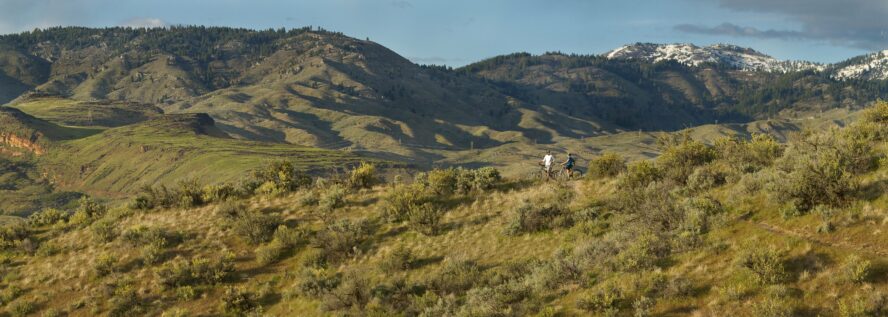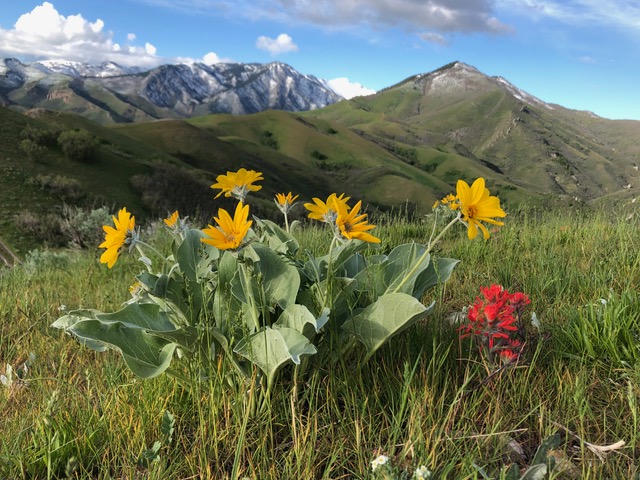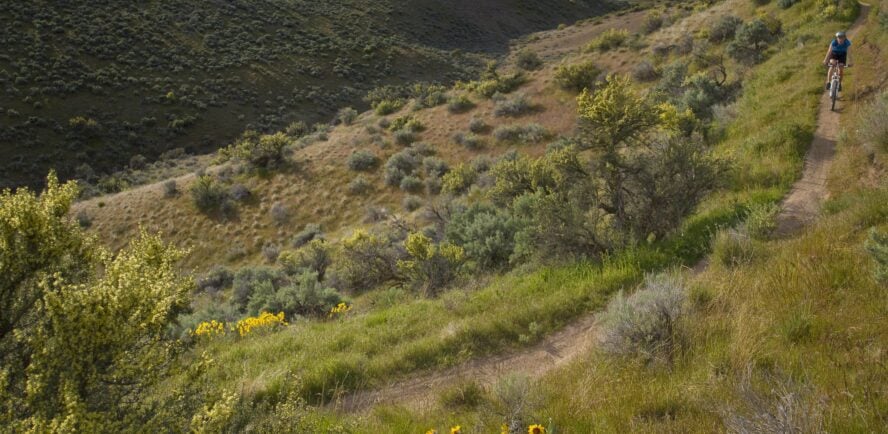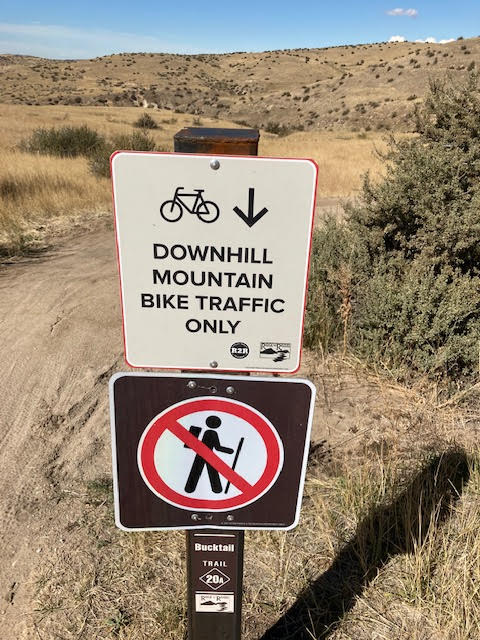I moved to Pocatello, Idaho, because I’m a fiend for the outdoors. Mountain biking, backcountry skiing, trail running, you name it. This nascent outdoor haven has it all, and without the crowds. At least for now.
All over the Mountain West, trail use has been increasing for years. Then during the COVID-19 pandemic it skyrocketed. In these multi-use systems shared by bikers, hikers, runners and motorized vehicles, trail managers are grappling with new challenges: how to reduce trailside degradation as well as conflicts and collisions between users?
Management strategies are being developed to cope, and I saw first-hand the benefits and difficulties on my recent vacation to Salt Lake City. It made me wonder, could Pocatello be next?

Off-Leash, On-Leash. What Doggone Day Is It?
I’m pacing around the trailhead while my best friend, Lily, is checking her phone. We’re standing in the parking lot of Mill Creek Canyon just outside of Salt Lake City, and my mom and I cast glances at each other confused. Both of us are visiting—she from Minnesota and me from Idaho—and we thought we’d do more hiking than loitering during our birthday weekend.
“It depends on the day whether dogs have to be on-leash or not,” explains Lily, who had recently relocated here. “It’s an even day [September 24th], so the dogs have to be leashed the entire time.”
I grumble, not comprehending. Unaccustomed to such specific trail management, I ask Lily if there are any other trail rules we have to follow and she lists a few: some trails in the area are solely for downhill biking, others are usable by bikes but only on certain days, while others still are open to both hikers and bikers but only in the uphill direction for the two-wheelers.

Not five minutes into our hike and I understand why our dogs need to be leashed. It’s an even day—which means bikes are also allowed on the narrow trail—and my dog hasn’t quite grasped “get out of the way” yet. It didn’t take long to appreciate the rule.
I was intrigued by Salt Lake’s trail practices and started researching more. I wanted to know why trail management is important to both users as well as the environment, and whether (or when) these kinds of efforts will be necessary in growing outdoorsy towns such as Pocatello.
Many of These Mountain Towns Used to Be Like Pocatello
In rural southeast Idaho, I can hike and bike the trail systems and rarely run into other people. For me, it’s one of the benefits of living in a small town and exactly why I decided to plant roots here. Aside from Lower City Creek Trail, which only allows uphill bikes because of low visibility, the majority of the systems are shared, multi-use, and multi-directional. They hardly ever clog with humans, which negates the need for land managers to intervene.
While Pocatello’s trails are quiet, cities like Salt Lake City and Boise, and uber popular destinations such as Aspen and Park City, require close management of the trail systems to provide safety, sustainability, and enjoyment for all users.
Trail management is not just for big cities
On our last full day, my mom and I decided to venture up to Park City to enjoy the scenic views and fall foliage. Before we got out of the car, I researched which trails are for hikers, and which we should avoid. Namely, those that allowed downhill biking.
Clear signage directed us from the parking lot to Jenni’s Trail, which only allows uphill riding—something my 63-year-old mom felt more comfortable with. Uphill bikers are slow and can easily make themselves known whereas downhill bikers rarely provide warning or time to get out of the way. When my mom and I reached a junction with a downhill bike trail we watched several bikers fly past us and were grateful to have done our research.

Mountain towns across the United States received an influx of people during the COVID-19 pandemic. Rentals and purchases increased in 2020—up to 156% in some cases—in Aspen, Colorado; Jackson Hole, Wyoming; Park City, Utah; Big Sky, Montana; and Lake Tahoe, California. The significant increase led to a swell of traffic on the local trails.
To gain a better understanding of what trail management strategies exist and the challenges that warrant intervention from trail managers, I hopped on the phone with Salt Lake City’s Foothills Natural Area Trail Project Specialist, Tyler Fonarow. Fonarow is part of the city’s Public Lands Department and helps oversee the nearly 6,000 acres of open space along Salt Lake’s urban footprint.
Major Challenges Facing Densely-Populated Trail Systems
Unplanned trails are rarely sustainable
“Without designated-use trails, users tend to venture wherever they please,” says Fonarow. “Trails that are not sustainably built tend to be higher maintenance because water does not run off them as well. In our foothills, we have a lot of steeper trails that are enjoyable for higher-skilled users but they are eroding out because water tends to hold rather than cross-drain,” Fonarow explains.
Planned trails are designed to protect the environment as well, which is not always a consideration for the ad hoc versions. “When we do our research on vegetation, wildlife and collection of resources, we’re trying to build trails that will have the least negative impact on our ecosystem,” says Fonarow.
Creating sustainable trails with the long-term in mind is important because user growth is rising quickly.

Rapid growth and user conflict
“Another piece that’s pretty motivating to get ourselves organized is the growth of mountain biking in Salt Lake City and the Mountain West,” says Fonarow. “The more biking gains in popularity, the more trail conflicts there will be. Pretty soon we’ll find that there aren’t enough trails for hikers and bikers to safely enjoy and recreate responsibly.”
It was for this very reason that my mom and I specifically sought out a hiking and uphill mountain biking only trail in Park City. My dog is still very young and relatively inexperienced at sharing a trail and my mom wears hearing aids, so it’s hard for her to hear other people coming. To avoid getting in a downhill biker’s way, we purposely stayed off of those trails. Ultimately, we had a much more enjoyable experience knowing we didn’t have to look out for bikes going mach speeds straight toward us.
Non-compliance
“It’s not good enough just to build trails but we also need to develop the culture around trail etiquette,” says Fonarow. “There’s a lot of education required and that’s our biggest challenge right now.”
Developing a program to manage a trail system is only half the battle, getting users to actually follow the rules is key. If a biker disregarded the uphill-only designation of the trail my mom and I were on in Park City, we could have been seriously injured, or at the very least, scared and annoyed. The same goes for foot travelers—honoring and respecting bike-only trails makes it a better experience for everyone involved.

When is enough, enough?
“If we’re building new trails, does that mean we’re attracting new users?,” asks Fonarow. “It’s a cycle of: if you bring in more users, you need more trails, and if you build more trails it’ll attract more users. So it’s this endless cycle of ‘what is the capacity?’”
SLC arguably has the best access to outdoor recreation from any major metropolitan area in the country. Residents can be on a hiking or mountain biking trail within a quarter mile of the state capitol, which inevitably attracts people—in large numbers—who are looking for an outdoor-urban lifestyle. In the last six years, the quick rise in usage has pushed the city to grow the division which oversees trails and natural lands from one person to a bigger team.
Over the past two years, Fonarow and his team have developed more than 15 miles of trail but more is in the works. “The plan for the next seven to ten years is to build over 100 miles of trail, within our budget, and to maintain staff and volunteer care,” says Fonarow. “Our hope is that the better the design of the trails, the less maintenance they’ll need to maintain.”
Popular Trail Management Strategies
On the flip side, trail management agencies have implemented a variety of solutions to help ease congested trails.
Accessibility and safety
Many designations work to spread users out across the trail system. Some strategies we’ve talked about already include single-use, such as hike-only and bike-only trails. Another popular tactic is to implement one direction of travel, such as bikes that can only go uphill or foot traffic that moves in a counter-clockwise route. To balance access for mixed use trails, the odd/even day regulations allow participants to still enjoy their favorite trail, just not everyday. In the end these arrangements often increase user satisfaction as trails can be reconfigured or specifically designed for a single activity with a lower likelihood of collisions.

Enjoyment for all
Trail managers have to develop a system that caters to all participants.
“Accessibility is one of the primary goals, Fonarow explains. While Moab is the highlight of any mountain bike season and Park City is some of the best riding in the country, they tend to attract more experienced (and aggressive) trail users, Salt Lake City is a major metropolitan area with a diverse group of recreationists. For this reason, Fonarow and his team worked diligently to create more beginner-intermediate type trails that are accessible to a wide range of users.
Trail Management Programs Are Expanding
Boise’s Ridge to Rivers Pilot Program
To gain a better understanding of how specific trail management programs are expanding across the Mountain West I looked to Boise. I caught up with David Gordon, the Ridge to Rivers Division Manager, to talk about the new pilot program, what it includes and how it’s been received by users so far.
The Boise Ridge to Rivers Pilot Program was developed to gauge the public’s interest in trail intervention. The program is an eight-month pilot that kicked off in April of this year, and residents have been vocal and engaged. They led with a webinar to answer any questions and develop strategies for the four trails that see the most traffic around the city’s foothills, and in the initial public survey, they garnered over 4,200 responses.
“We’ve seen an increase of use in our trail systems for years” says Gordon. “Then COVID exploded last summer and use really skyrocketed. So that’s what predicated our decision to try some management strategies.”
On the four most popular trails in the Boise Foothills, the Ridge to Rivers Pilot Program implemented several specific schemes. At Lower Hulls Gulch Trail #29 they used an odd/even day system which only allows downhill bike use on odd numbered days of the month. On even numbered days, the trail is open to foot traffic and equestrian use in both directions, as well as uphill biking. On Polecat Loop Trail as well as Around The Mountain Trail #98, the pilot program has designated these to a single direction, meaning everyone must travel counter-clockwise. Lastly, a parallel trail, Bucktail Trail #20A, which is only accessible by pedestrians, has been developed between Central Ridge and Bucktail Trail to modify the existing Bucktail Trail for downhill bike use only and uphill mountain bike access via Central Ridge.

While all of the trail strategies have been put in place to benefit everyone, Gordon anticipated push-back from avid users. A mid-program survey, which was sent out in the summer, showed even more support for the management strategies once residents had a chance to try them out.
“Three months out, support is actually higher,” Gordon professes with excitement.
The pilot program in Boise runs until November 21, at which point a final survey will be sent out to residents. If the majority of respondents support the strategies in place, the program will lose the word ‘pilot’ from its title and the four trails involved will continue to be managed as they have been the last eight months.
Pocatello could be next
Trail management is not totally out of the question for a place like Pocatello. The 60,000 people who currently call this southeast Idahoan town home—10x the population of Aspen and Park City by the way—can comfortably recreate on the many accessible trails. Still, we just have to look to our mountain town neighbors for how quickly things can change.
So do I need to start taking my dog out on a leash every other day? Based on the number of people moving to Idaho, it might make sense to plan ahead sooner, rather than later.
Our Responsibility as Recreators
As I learned on my trip to SLC, there’s a lot to consider when recreating in a popular outdoor area. Here are a few tips to help you recreate responsibly on your next trip.
-
- Know before you go: Whether you’re visiting a new area or just exploring around your neighborhood, it’s imperative to do your research ahead of time to understand the regulations of where you plan to recreate.
- Respect the rules: If a trail is designated for a single use or to be used in a single direction, follow them. There’s nothing more infuriating than coming up on a hiker on a bike-only trail or dodging free-running dogs that are supposed to be leashed. These regulations exist not only for user enjoyment, but also for safety.
- Recreate sustainably: Always stay on designated trails to reduce the impact on surrounding vegetation and wildlife habitat. That goes for dogs, too.
- Be a steward of the land: Always pick up after your pets and whatever you pack in for your hike, run or bike ride, make sure to also pack it out and dispose of it properly at the trailhead or at home. Notice someone not following the rules? Respectfully remind them, it may be that they are new to the area and unaware of the trail management strategies.
- Get involved: Get involved with developing and maintaining your local trail systems! Volunteer.gov is your best bet at finding government public land volunteer opportunities near you.





